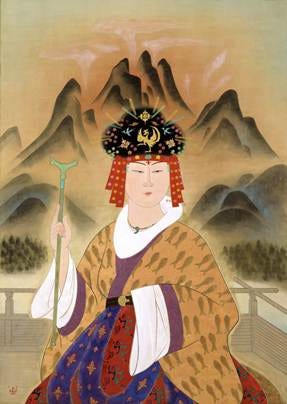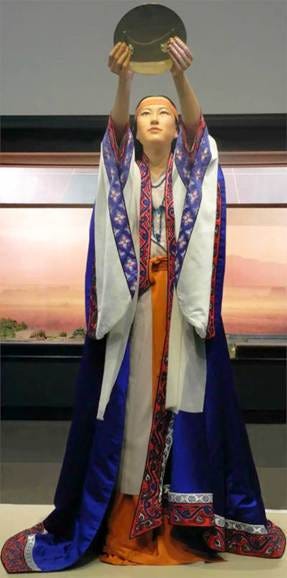Queen Himiko: The Shaman Ruler Who Haunts Japan's Ancient Past
By Dr Christopher Harding
One of the greatest mysteries in Japanese archaeology is the resting place of Queen Himiko. The first named person in all of Japanese history, she is thought to have lived between 170 and 248 AD. Chinese accounts paint a picture of Himiko as an awesome but shadowy presence in her land:
“There were few who saw her. She had one thousand women as attendants, but only one man. He served her food and drink, and acted as her medium of communication. She resided in a palace surrounded by towers and stockades, with armed guards in a state of constant vigilance.”
Dr Chris Harding is a senior lecturer in Asian History at the University of Edinburgh. He writes on wide range of topics, including history, politics, religion and pop culture, for publications including BBC History magazine, The Guardian, The Telegraph, UnHerd and The New York Times.
His Substack newsletter, IlluminAsia, is free to read and subscribe.
Exclusive…Ancient Origins Unleashed paid members will enjoy an exclusive in-depth interview with Dr Harding, where he shares further insights into Himiko, including intriguing connections to the Tomb Raider movie and deeper archaeological context. Subscribe as a paid member now so you don’t miss this interview and other exclusive content only available to paid members.
Queen Himiko and the Rise of Ancient Japan
Himiko ruled a chiefdom called Yamatai, one of countless small polities dotting the Japanese archipelago in this era. She seems to have controlled both her own population and those of neighboring, subordinate chiefdoms with a mixture of armed power and what Chinese observers regarded as sorcery. Himiko was not just a queen, she was a shaman-queen: most likely using bells, mirrors, dances and incantations to commune with the gods, in order to keep nature onside and ensure good harvests.
Himiko was sufficiently powerful that her people were said to live in fear of her. When she died, her kingdom fell into disarray without her to guide it. ‘A king was placed on the throne,’ claims the Chinese Records of Wei, ‘but the people would not obey him ... assassination and murder followed.’ Only when Himiko’s niece, just 13 years of age, was placed on the throne, did the kingdom become calm once again – perhaps because of a reverence for Himiko’s bloodline.
The legend of Himiko resonates right down to the present day: for fans of the Tomb Raider video game reboot in 2013, which features Himiko and Yamatai; and for archaeologists and historians for whom the discovery, one day, of her resting place has the potential to unlock Japan’s past.
Some believe that Himiko’s tomb, and with it the ancient kingdom of Yamatai, is located somewhere on the southern Japanese island of Kyushu. Others suggest Nara prefecture, in central Japan. The latter would make for a fascinating find. Japan’s imperial family can already trace its line back around 1500 years, to a clan hailing from central Japan. The prospect remains open – if perhaps rather remote – that the present-day Emperor, residing in a palace at the heart of Tokyo’s bustling metropolis, may be the distant descendant of one of the most formidable women ever to have walked the archipelago.
Who were the Ancient Japanese?
The first written Japanese records date back only as far as the early 700s AD. In its absence, there is much that archaeology can tell us about the ancient Japanese. But some of the most striking evidence about who they were and how they lived comes down to us via Chinese observers whose impressions form part of a chronicle known as the Records of Wei (late third century AD).
Anyone who has visited Japan will be tempted to see in these ancient accounts a foreshadowing of how Japanese life works today. We find a deep reverence for nature, going far beyond mere pleasure at its sights, sounds and tastes to include an awareness of an intelligent vitality coursing through it, capable of shaping human affairs. We encounter, too, a sense of connections being made between these natural and supernatural features of the world, on the one hand, and the ordering of society on the other.
By the time of the third century AD, humans had been living on the Japanese archipelago for perhaps around 30,000 years. Archaeologists have found evidence dating as far back as 14,500 BC of hunter-gatherer communities storing and cooking food in clay pots, eventually settling down into small communities of between five and several dozen thatched pit homes. This period, running up to around 500 BC, has been called the Jōmon period, after the rope pattern found on some of the pottery.
By the time that Chinese observers arrived, the archipelago – not yet known as ‘Japan’ – was well into a second major period, the Yayoi, beginning around 500 BC (perhaps a little later) and characterized by the influx into Japan of rice agriculture and iron tools. The people whom the Chinese referred to as the ‘Wa’ were divided into chiefdoms, some encompassing thousands of people. Grizzly evidence reveals regular warfare – one individual, either spectacularly unlucky or stubbornly unwilling to die, was found with no less than a dozen arrows protruding from what remained of his body.
Nowhere was reverence for nature more profound or pronounced than in ritual worship, with which the enigmatic figure of Queen Himiko (c. 170 – 248 AD) is closely associated. She ruled her kingdom of Yamatai and the lesser chiefdoms surrounding it through a combination – if Chinese records are to be believed – of ‘magic and sorcery,’ fear and force. Archaeological finds suggest that a shamanic ruler like Himiko would have communed with the gods at specific locations (perhaps linked to remarkable features of the landscape, including waterfalls, trees and mountains) and using a combination of ritual, dance and brass objects including bells and mirrors.
Hit subscribe now to become a paid Ancient Origins Unleashed member and gain access to all the exclusive member content, including the in-depth interview with Dr Harding.
Himiko’s fearsome reputation, and her ‘strict and stern laws,’ may explain why the Chinese were impressed with the behavior and manners of the ancient Japanese. Women wore simple coverlets of spun fabric and were ‘not loose in morals, or jealous,’ according to the Records of Wei. The men dressed with equal simplicity and were inclined neither to theft nor to litigation. They spent their days instead cultivating rice, grains, hemp and mulberry trees, for raising silk-worms. They went diving for seafood, tattooing their faces and bodies in order to ward off dangerous or troublesome sea-creatures.
This was a deeply hierarchical society. Himiko existed either at the top or perhaps beyond society altogether. Lower down, one found men wealthy enough to keep several wives and to be assured that when they passed by on the road, lesser folk would squat or kneel before them, both hands pressed to the ground. ‘This,’ concluded the Chinese chronicle, ‘is how they show respect.’ Wealth was protected not just by respect but by the threat of formidable punishments. A light offence could lose a man his wife and children ‘by confiscation.’ A more serious infraction would see him, his household and some of his extended family ‘exterminated.’
An awareness no doubt existed, too, of actions having consequences beyond human society. Alongside evidence of shamanic rituals, the forerunners of what became Shintō, we find suggestions that purity and pollution were central elements in Yamatai life. When someone died, the Wa would mourn for at least ten days. They would wail and lament; sing, drink and dance. At the end of it all, family members would take a purifying bath.
Strenuous efforts were meanwhile made to secure the safety of lengthy sea voyages:
They select a man who does not comb his hair, does not rid himself of fleas, lets his clothing get as dirty as it will, does not eat meat, and does not lie with women. This man behaves like a mourner and is known as the ‘mourning keeper.’
When the voyage meets with good fortune, they all lavish on him slaves and other valuables. In case there is disease or mishap, they kill him, saying that he was not scrupulous in observing the taboos.
Divination was used, too, including scapulimancy. The shoulder-blade of a deer would be placed in the fire and its fissures examined for signs and portents. Deer seem to have been the subject of particular reverence on the archipelago. Some of the earliest Japanese writings, when they did at last appear, included stories of rice seeds being planted in deer’s blood, and germinating overnight.
In the centuries after Himiko’s death, battles between rival clans gave way to the emergence of something resembling a state in central Japan. It drew heavily on Chinese inspiration but at its head was an Emperor claiming special status. While his Chinese counterpart fretted over respecting and retaining the ‘mandate of Heaven,’ the Japanese Emperor claimed actually to be descended from the gods. Japan perhaps owes, to this remarkable ancient period of shaman-rulers and deep sensitivity towards nature, much of what differentiates it, even today, from China and Chinese culture.
Quite what became of Yamatai, and even where it is located, remains unknown to this day. It may have been located on the southern Japanese island of Kyushu. Or perhaps remains will eventually be found in central Japan instead, connecting Queen Himiko and her people to the line of emperors and empresses who are still with us now. Archaeologists must, however, contend with Japan’s conservative approach to excavating burial sites, particularly those thought to be associated with great rulers of the past. It may be that for many years yet, Himiko and the ancient Japanese will continue to be mysterious to us.
Top image: Rendering of Queen Himiko. (ChatGPT Image Generator)
By Dr Christopher Harding
Dr Chris Harding is a senior lecturer in Asian History at the University of Edinburgh. He writes on wide range of topics, including history, politics, religion and pop culture, for publications including BBC History magazine, The Guardian, The Telegraph, UnHerd and The New York Times. His substack newsletter, History with Chris Harding, is free to read and subscribe (link).
Remember… hit subscribe now to become a paid Ancient Origins Unleashed member and gain access to all the exclusive paid member content, including the exclusive in-depth interview with Dr Harding.








Learn something new everyday! Thank you for another informative article!
I wonder how Japanese culture ended up so patriarchal...I wonder how Japanese culture ended up so patriarchal...